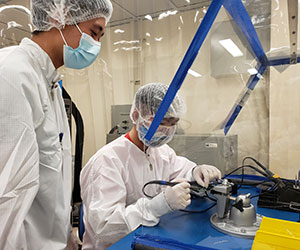A new earth and planetary exploration technology (EPET) certificate is preparing students for the Earth and space exploration workforce in their major science or engineering discipline, and the first cohort will graduate in December from the University of Hawaiʻi at Mānoa. The certificate program is provided by the Hawaiʻi Institute of Geophysics and Planetology (HIGP) and supported by the Hawaiʻi Space Flight Laboratory.
“The EPET certificate program is one of the only opportunities for UH students to obtain a formal education in an important growth area of the economy, space exploration and aerospace engineering,” said Peter Englert, a professor in HIGP. “It is also one of the few programs where science and engineering students will work together on course projects, an enriching experience, and an opportunity.”
The EPET certificate program consists of four courses totaling 15 credits that are taught in four consecutive semesters starting in the spring. The courses are cross listed with mechanical engineering and form the core of the concentration in aerospace engineering of the Mechanical Engineering Department. Program goals are to provide science and engineering majors with a comprehensive understanding of scientific and engineering knowledge, in theory and practice, to successfully explore from the deepest oceans to the far reaches of our solar system.
“I thoroughly enjoyed the EPET program,” said Lynzee Hoegger, who is in the first cohort of the EPET certificate. “It’s been really great getting to be a part of the bridge between space science and technology. I also enjoyed that we didn’t just hear from one professor with one area of expertise but instead many different professors from many different fields would teach us each week.”
This certificate is an example of UH Mānoa’s goal of Enhancing Student Success (PDF), one of four goals identified in the 2015–25 Strategic Plan (PDF), updated in December 2020.
The EPET curriculum provides a modern learning experience by combining lecture-, laboratory-, field- and project-based approaches with effective interdisciplinary group learning strategies to integrate the nature of planetary materials and landforms with the science and engineering tools. These include sensors and scientific instruments, robotic vehicles as platforms for remote sensing and sampling, spacecraft fundamentals, and mission architecture, planning and operation.
“I would recommend the certificate to other students because it gives you a chance to work with people outside of your major and to have to think outside of the box to solve problems that may arise in a space mission,” said Hoegger.
The satellite that students are completing in fall 2021 will likely be part of the Pleiades Mission together with Cal Poly Pomona, Portland State Aerospace Society and Stanford University. The payload is a general radiation detector.
“It is also fun to work on research projects that design and build space flight sensors, space flight missions, and finally a small functioning spacecraft,” said Englert. “Some of these spacecrafts will have an opportunity to be launched while students are still in school.”
The EPET certificate program is for students enrolled in science and engineering undergraduate degree programs at UH Mānoa, other parts of the UH System, and other universities. The program can also accommodate professionals working in the community who wish to upgrade knowledge and skills.
The next cohort of students for the EPET certification program will begin in spring 2022. For more information, see HIGP’s website.
Hawaiian Word of the Week: Mauō
If required, information contained on
this website can be made available in
an alternative format upon request.
Get Adobe Acrobat Reader
Calendar
Directory
Emergency Information
MyUH
Work at UH






